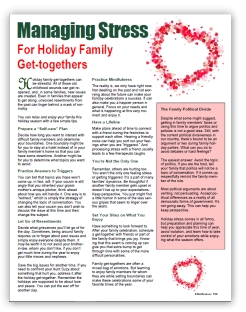Enjoy the Stress--It's Not All Bad
Stress Isn't Always Bad for You -- Here's Why
Although stress is a normal part of everyday life, we typically think of it as a bad thing. The reality is that some stress challenges us to improve ourselves because it pushes us beyond what we think we can handle. Without stress, then, we don't grow or adapt to new challenges. Here's why we should welcome some stress into our lives, and some tips on telling the difference between healthy and unhealthy stress levels.
What Is Stress?
Stress is a natural response to change. It's the mental and physical symptoms you experience when you're exposed to new challenges or when you feel under pressure. Stress causes symptoms such as:
• Elevated heart rate
• Muscle tension
• Faster breathing
• Trouble sleeping because of racing thoughts and heightened awareness
• GI problems e.g. nausea and stomach upsets
When you experience stress, your body releases a wave of hormones through the bloodstream. These hormones, such as adrenaline and cortisol, help you react quickly to a challenging or threatening situation. This is otherwise known as the "fight-or-flight" response.
The body produces the same hormonal response whether you're running for your life or getting ready for a first date. In other words, stress is never going to be eradicated from modern life, but the good news is that some stress is actually healthy.
Yes, really. Not all stress deserves a bad reputation. Let's consider why.
Some Stress Is a Good Thing
Not all stress is created equal. Luckily, the most common stress we face each day is acute stress, and it's the least worrying form of stress. In fact, acute stress can improve our performance, sharpen our minds, and help us retain new skills.
Acute Stress
Acute stress is caused by a recent event or an accumulation of multiple tasks. For example, you might be stressed by:
• Exams
• An upcoming wedding
• Arguing with a friend
• Looming deadlines
This stress only lasts for a short time. Once the triggering event is over, the stress disappears.
Why is acute stress sometimes a good thing, then? It's simple. Stress pushes us into action. If we didn't stress out over exams, we wouldn't study. If we didn't fret over deadlines, we'd leave tasks unfinished. And, thanks to sharpened reactions, stress lets us overcome challenges and solve problems that we couldn't figure out before.
Stress can be a motivator. It's pretty uncomfortable, but it forces us to get results. Think of it like exercise. The more you train, the stronger you become. Acute stress has the same effect.
Good v Bad Stress
So it's clear that some stress actually benefits us, but what about when stress is harmful? Chronic stress is when the body is constantly in fight-or-flight mode. When this is the case, the pressure wears you down eventually. Chronic stress can be caused by:
• Working as a caregiver to a sick relative
• A toxic workplace environment
• Unhappy or dysfunctional family
• Long-term health problems
• Ongoing poverty or job loss
Chronic stress is dangerous. It causes long-term mental and physical symptoms, and it may lead to heart disease, obesity, or skin conditions.
Tips for Managing Stress
Since some stress is a normal part of our lives, we must learn to deal with it. You can:
• See a stressful situation as a challenge, not an impossibility
• Accept when you can't control a situation
• Avoid harmful responses to stress such as alcoholism
• Get help when stress becomes a problem
• Develop your organizational skills to stay on top of tasks before they become too stressful
Remember, stress can mean you're pushing yourself outside your comfort zone. You don't improve yourself when you're comfortable. Stress, under the right conditions, can inspire and motivate you to achieve your full potential.
To get a Stress Management Training PowerPoint Show that is editable for live or "movie like" showing, go to WorkExcel.com shopping cart here.



 in the workplace.
in the workplace.